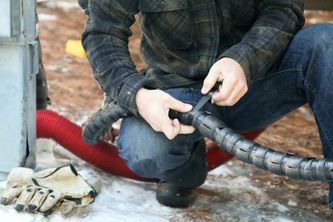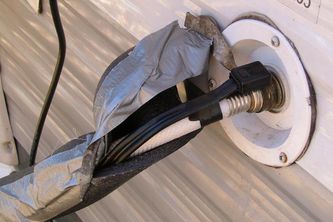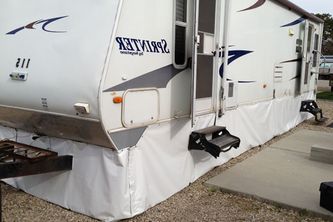how to install heat tape on pex pipe
The cold can be fun or i t can be your enemy. Cold weather has a way of freezing your pipes, holding tanks and other RV equipment making them hard to use. You want to be prepared when the cold strikes and make sure you have enough heat tape on hand to beat it back
How to Install Heat Tape on an RV Water Line or Holding Tank: You can use heating tape like any other tape on the market today. The only difference is you can have some space between each spiral wrap. Usually, that gap is at a minimum of 1/8 of an inch. You can go larger if you want.
To find out more about how to use heating tape and protect your RV this winter, keep reading our article. Wit gives you the information you need to know so your water line and holding tanks are safe through those cold months.
Heat Tape for an RV Water Hose

The basic heat tapes are called resistive heaters and they all carry electrical wires to conduct the heat. When you are looking for good heat tape to use, keep in mind that the temperatures they emit vary.
Some brands will give off 300 watts of heat while others will reach 900 watts. There are also those brands that can go as high as 1400 watts. Which temperature level you use is up to you and the cold conditions your water line will experience.
Once you get the tape on the best operating time is between 6 am and 6 pm in mild conditions. Also, you can leave the tape plugged in 24 7 if the situation requires it to be left on.
There are 2 Kinds of Heating Tape You Can Use.
- #1. Non regulating
This is a very simple to use variety and it comes by the foot or in rolls. They also work on most RVs with no issues or hassles. The only thing to keep in mind is that you should not leave this style of tape on while you are not home.
Because they are non regulating, these types of heating tape need human assistance to change their heat levels. This nature makes them a bit of a fire hazard when you are not around.
- #2. Self Regulating
Unlike the styles of heat tape in number one, the styles here do regulate their own heat levels and automatically change their temperature when the outside temperature changes.
This style of heat tape is easier to use and maintain plus they are not as much of a fire hazard as non-regulating heat tape. Also, they can be hard-wired into your RV's electrical system or modified to plug into a regular outlet.
Water Hose Heat Wrap

One style of heat wrap comes with 2 major components- the heat tape and the foam insulation. You can run the heat tape linear along with the hose without wrapping it. Then you should use electrical tape and attach the heating coil to the hose every foot.
After you have done that, you wrap foam insulation around the hose, to make sure the heat tape does its job. This helps to keep the tape from coming loose and keep the heat inside while keeping the cold out.
Also, you can wrap the foam insulation, the kind that has the slit for hoses to fit easily inside, to make sure everything stays nice and warm. Pipe insulation tape will handle that task without any difficulty.
Finally, connect the prepared hose to your RV and tap and then plug the heat cable in to start getting the line nice and warm.
Also, you can purchase your heat wraps. There is a variety of them on sale and they will save you a little time and trouble. Some of these brands protect against high hot outside temperatures as heat is something to be concerned about just as much as freezing can be.
You do not want your lines melting or being damaged because there is too much heat.
RV Sewer Pipe Heat Tape
There is no special brand of heat tape just for sewers that we could find. Regular heat tape, of either style mentioned above, will handle your sewer lines quite well. Although you may want to go with the self-regulating kind over the not regulating kind due to the possible fire hazard the latter comes with.
To make sure you get it right, do not let the heat tape cross over itself. If you do cross the tape over itself, you are opening up to a short circuit and defeat the purpose for why you are using the tape in the first place.
Also, you should plug into a GFCI circuit only for further protection and safety. When it comes to the valves it is said that Ultraheat has heat products that will keep them nice and warm.
When you attach the heat tape to your sewer hose leave about an inch gap between spiral wraps. Then insulate the pipe because the heat tape may get only so hot and the extra cold may overpower it.
After that, because the heat tape takes a while to warm up you may want to do it the night before to let it have time to get hot. Or you can just let it run all the time to make sure the sewer hose is properly heated.
Heat Tape for RV Holding Tanks
It is possible to use heat tape on holding tanks but there are a couple of warnings that come with their use. The first warning is that they may not work well on holding tanks. The second warning is that this tape may only be good on plastic or metal pipes.
Your results may vary but be careful. Instead of using heat tape you could use heating pads that are designed to keep your holding tanks from freezing over. A couple of these should do the trick and they cost a lot less than the heating tape does.
The pads should hook up to standard electrical outlets without a problem. Plus, many of the pads are rated to handle temperatures as low as -11 degrees F. Then these pads should only be turned on when there is actual water inside the holding tanks.
And when the temperature starts to dip below freezing or getting close to that temperature mark. The pads should be turned off when the temperature remains above freezing, no liquid in the tanks, when you are dumping your holding tanks and when you are connected to the city water lines.
DIY Ideas and Tips

One simple tip that helps keep yo ur RV water lines and holding tanks from freezing is to use a light bulb. Just arrange it where it will cast off the most heat and keep as much of the compartment as warm as possible.
Light bulbs can be cheap and can save you time and money over using heating tape. But be careful, not every light bulb will withstand extreme cold temperatures and keep the compartment nice and warm.
When you are RVing in cold temperatures, you should keep your gray tanks nice and closed till it is full. You can still attach the heat tape but keeping them closed keeps a lot of water from getting stuck in the valves and becoming frozen.
If you do use heat tape, make sure to leave the thermostat out of the insulation and don't tape over it. It must react to the temperature for the tape to work well. Another trick is to put the insulation tape over your hose first. Then put the heat tape on.
What this does is protect the hose from separating during those cold days. That separation may cause some leaks to take place which is an issue that can create headaches for you.
Another trick you can do, if you do not already have it, is to make a canvas skirt to keep the wind out from underneath your RV. The canvas skirt is heavy-duty, flexible and should keep a lot of cold temperatures away from your vital RV parts
Then when you break camp and move on to another site, you can roll the canvas skirt up and store it in your truck or RV for when you stop for a few days.
Some Final Words
Winter RVing is not out of the question when you have top quality heat tape on hand. These rolls of tape can unwind quickly and plug into your regular outlet or be hard-wired in. Either way you do it, your pipe and water lines should not freeze.
All you need to do is apply the tape properly then leave a gap between strands so you do not cause a short circuit. You also do not want to criss cross the tape for the same reason.
When dealing with holding tanks, it is not advisable to use heat tape. Heat pads are better and cheaper. Keeping your pipes and holding tanks from freezing won't be too difficult when you use the right kind of heat tape or pad for the job.
how to install heat tape on pex pipe
Source: https://thecampingadvisor.com/how-to-install-heat-tape-on-an-rv-water-line-or-holding-tank/
Posted by: smithweriatere.blogspot.com

0 Response to "how to install heat tape on pex pipe"
Post a Comment